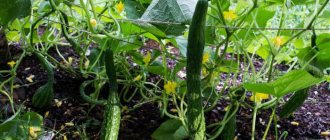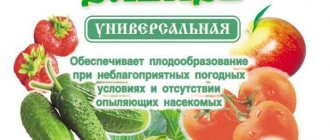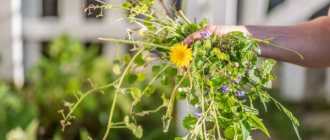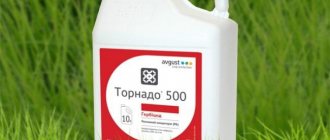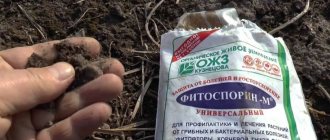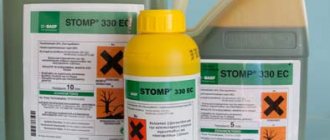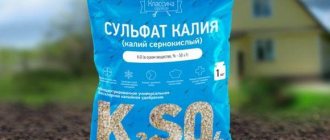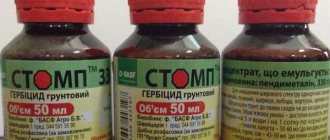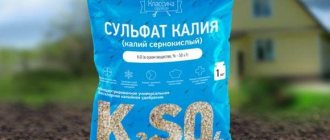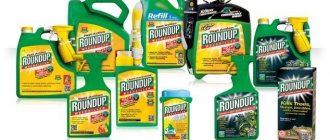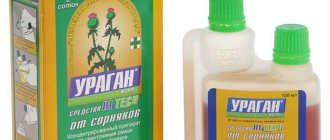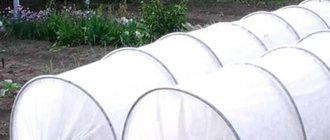The name of the product speaks for itself - it helps most vegetable and fruit plants set strong fruits and increases their yield by more than a third. You can call it whatever you want - a stimulant, a fertilizer for foliar feeding, the essence does not change: “Ovary” helps to cope with unfavorable factors that interfere with the appearance of long-awaited high-quality vegetables, berries, and fruits.
However, the main difference between “Ovary” and traditional fertilizers used for root and foliar feeding is that the components included in the stimulator are in fermented form and are absorbed by the plant record-breakingly quickly, without affecting the growth of tops.
When using fertilizer, you will be able to harvest the first harvest earlier than usual, which will bring good profits if you grow fruits for sale. In addition, the harvested fruits will be larger and sweeter, making the harvest more competitive. In addition, the fertilizer promotes the formation of ovaries on plants that are grown on not very fertile soils and in conditions of a small number of pollinators.
What to do to stimulate the formation of ovary on tomatoes
Eliminating the consequences of the identified cause of the absence of ovaries on tomatoes and other plants is not easy.
And sometimes it takes too much time to determine the essence of the problem, and it will no longer be possible to save the crop of the current season. Therefore, gardeners must take all measures to reduce the prerequisites affecting the formation of fruits.
If you have to face such a question, then the best solution is to use folk remedies or special preparations, the action of which is aimed at stimulating fruit formation and preventing the ovaries from shedding.
Many gardeners successfully use the drug Ovary. After treatment with the product, plants can more easily tolerate temperature changes, drought or high humidity.
Drug Ovary
In addition to stimulation, spraying strengthens the immune system, which allows the shoots to resist fungal infections and other equally serious diseases. The effect after using the drug is noticeable in a matter of days, and the effect of the active components continues for 30 days.
Composition of the product
The drug is a universal stimulator of fruit formation, made exclusively on a biological basis. Today, a whole series of stimulants of the same name has been developed for certain vegetable crops, including tomatoes. It should be noted that when growing tomatoes you can use not only the “Ovary for tomatoes”, but also the “universal” one. When creating each product in this series, the characteristics of fruit formation and the requirements for the concentration of active substances of each vegetable crop were taken into account - that is why it was possible to achieve the maximum effect from using the drug.
The product contains natural growth components that nourish fetal tissues and enhance its growth. These are mainly micro- and macroelements in combination with a natural complex consisting of acids. Sodium gibberellic acid is the main active ingredient of the drug. These are natural salts that do not cause any harm to plants and do not affect the benefits, quality and taste of tomatoes.
Sodium salts of gibberellic acid belong to hazard class 3 - this means that in high concentrations the substance has minimal toxic effects on humans, but in the correct dosage it is completely harmless. This explains why a properly diluted stimulant cannot cause harm when consumed. In addition, the concentration of salts in the mixture is 5.5 g/1 kg, which is completely safe for any living organisms and soil.
How does the drug work and why is it so effective? During the action of stimulating substances on the tomato ovary, metabolic processes are activated, which leads to a stop in the shedding of flowers and the growth of even unfertilized ovaries. It is due to unfertilized (seedless) fruits that the yield of tomatoes increases, since they are particularly large in size and have good fleshy pulp. Thanks to Ovary treatment, fruits ripen faster and, accordingly, earlier, and the overall yield increases by 15-30%.
All the subtleties of fruit formation
First, let's remember the basics of botany, known to everyone since high school. In order for a fruit to form, flowering (angiosperm) plants have a special organ designed for reproduction (generative), the flower.
O Fruit! How far are you from me? I am hidden in your heart, O Flower! (Rabindranath Tagore)
All this information fringe about stamens and pistils, ovules and ovaries, described in a school textbook, is not entirely clear and of little interest to most non-botanists. It is important that, according to most modern scientists involved in plant physiology, a flower is a modified shoot formed by a plant from generative tissue. For flowering and subsequent fruit formation to occur, a combination of external and internal factors is necessary.
- The plant must reach sexual maturity, that is, the ability to reproduce. To do this, you need to go through the stage of vegetative development - grow a certain number of leaves. So, for example, in tomatoes, the first flower cluster is formed after 3-4 leaves (determinate varieties) or after 9-12 leaves (indeterminate varieties) - this is an internal factor.
For a plant to bloom, a combination of external and internal factors is necessary.
- Certain external conditions must be met, such as air temperature and daylight hours. And this will be an external factor. Thus, tomatoes will not bloom if the air temperature is below +15°C, and if above +35°C, fertilization will not occur and fruits will not set.
The conditions are met - the process has begun
The simultaneous fulfillment of these 2 conditions triggers the flowering process: the cells of the apical tissue are separated and some of them are converted into floral tissue - the flower is laid.
Elusive florigen
As mentioned above, phytohormones serve as a signal for the appearance of a flower instead of another shoot. It is difficult to single out just one substance that is responsible for flowering. Back in 1937, Soviet plant physiologist Mikhail Chailakhyan suggested that a certain hormone-like molecule, which the scientist called florigen, the gene responsible for flowering, is responsible for the initiation of this process in plants.
tomato flower
However, all attempts to isolate the gene responsible specifically for the appearance of flowers have so far been unsuccessful. Today, botanists agree that flower buds are formed mainly under the influence of a pair of hormones: auxins or gibberellins and the mysterious florigen. But these phytohormones act differently on long- and short-day plants. Some studies also show that the transition of a plant to flowering is also influenced by cytokinins produced in the roots.
Precautionary measures
The drug “Ovary”
is completely phytotoxic and, as we said earlier, belongs to hazard class 3.
This indicates that it cannot cause significant harm to health, but there are rules that must be followed, especially for those people who are prone to allergic reactions
.
Before using the drug, you must wear rubber gloves, protect the entire surface of the skin with clothing, and hide your hair under a hat. It is strongly recommended to protect your eyes with goggles, and your mouth and nose with a gauze bandage or a respirator. It is strictly forbidden to use food containers for diluting and using the drug.
If the drug does get on the skin, it should be immediately washed with running water and laundry soap.
. If the solution gets into your eyes, you should rinse them with plenty of clean water and visit an ophthalmologist as soon as possible. If the drug enters the stomach through the oral cavity, then you must immediately drink several glasses of clean water and take activated charcoal at the rate of 1 tablet per 1 kg of body weight.
We hope that our article was interesting and informative for you!
If you study the offerings on the market, you will notice that several products are produced under this brand. There is “Ovary” for specific crops, for example, for tomatoes, and there is a universal one.
It is universal and most popular. The universal “Ovary” can be used for spraying:
- tomatoes;
- cucumbers;
- potatoes;
- eggplant;
- sweet pepper;
- currants;
- garden strawberries;
- grapes;
- peas;
- beans and many other crops.
What are the benefits of using Ovary
This drug is not dangerous for humans, animals, soil and plants. In addition to no harm, the product has a noticeable beneficial effect on many common garden crops:
The drug has a similar beneficial effect on other garden crops - cauliflower, squash, pear, apple tree.
Types of plant growth regulators and method of their use:
* Plant growth regulator Agat-25 K
(pseudomonas aureofaciens pseudobacteria, strain H 16 and metabolic products), flowing paste.
Used to increase germination and productivity, stimulate the immune system, and reduce morbidity. Agat-25 K, instructions for use:
Treat potato tubers before planting. For 50 kg, take 0.5 liters of solution containing 7 g of paste.
Soak tomato seeds (3.5 g of paste per 1 liter of water), carrots and cucumber (4-7 g per 1 liter of water) for three hours. For pre-sowing treatment of beet seeds, you need to mix 110-130 mg of paste in 30 ml of water.
In the phase of 2-3 leaves, carrot, cucumber, pepper, and tomato plants are sprayed, and in the phase of closing rows, table beets are sprayed. For one hundred square meters, 3 liters of solution containing 140 mg of Agate-25 K
.
* Plant growth regulator Ambiol
(2-methyl-4-dimethylamino-methylbenzamidazole-5-ol dihydrochloride), crystalline powder. In order to increase yield and resistance to downy mildew, cucumber seeds are soaked in a solution of 10 mg/l for 6 hours before sowing.
Ovary preparation is a stimulator of fruit formation in vegetable and fruit crops. Ensures fruit set in hot and cold conditions, drought and rain in the absence of pollinating insects. Reduces ovary abscission and increases productivity.
Use and application of the drug Ovary:
contents of the package - 2 grams - dissolve in water according to the instructions, mix thoroughly, use the solution within an hour. Fine-drop spraying of plants should be carried out in the morning or evening hours in dry, windless weather or at a wind speed of no more than 5-6 m/sec, at a temperature of 15-25 C.
Culture: tomatoes (open and closed ground).
Consumption rate of the drug Ovary: 2g per 1 liter of water. Working fluid consumption: 0.3 l per 10 m2. Treatment during flowering of the 1st, 2nd and 3rd clusters.
Culture: eggplant, pepper.
Consumption rate of the Ovary regulator: 2g per 1 liter of water.
Culture: cucumber (open and closed ground).
Consumption rate for Ovary: 2 g per 1.4 liters of water. Working fluid consumption: 0.3 l per 10 m2. Treatment at the beginning of flowering (appearance of single flowers) and mass flowering.
Culture: white cabbage (early and late varieties).
Working fluid consumption: 0.3 l per 10 m2. Treatment in the phase of 6-8 leaves and the phase of beginning to set a head of cabbage.
Culture: potato.
Consumption rate of the Ovary stimulator: 2 g per 2 liters of water. Working fluid consumption: 0.3 l per 10 m2. Treatment at the beginning of mass flowering and 7 days after the first treatment.
Culture: vegetable peas.
Consumption rate of the fruit-forming agent Ovary: 2 g per 3.3 liters of water. Working fluid consumption: 0.3 l per 10 m2. Treatment at the beginning of budding and flowering.
Culture: beans.
Consumption rate of the drug Ovary: 2 g per 1.4 liters of water. Working fluid consumption: 0.3 l per 10 m2. Treatment at the beginning of budding and flowering.
Culture: grapes.
Consumption rate Ovary KRP: 2 g per 1 liter of water Consumption of working fluid: 1.5 liters per 10 m2. Treatment at the end of flowering.
Culture: raspberry.
Working fluid consumption: 0.4-0.6 l per 10 m2. Treatment during budding and green ovary phase.
Culture: currant.
Consumption rate of Ovary: 2 g per 1 liter of water Consumption of working fluid: 0.6 liters per 10 m2. Treatment during budding - the beginning of flowering and the phase of green ovaries.
Culture: garden strawberry.
Consumption rate of the Ovary stimulator: 2 g per 1 liter of water Consumption of working fluid: 0.4 liters per 10 m2. Treatment when flower stalks appear and again after 7 days.
Culture: pear, cherry, plum, apple tree.
Consumption rate of the drug Ovary: 2 g per 1 liter of water Consumption of working fluid: 0.4-0.6 l per 10 m2. Treatment during flowering and petal fall.
Where to buy the drug Ovary?
The Ovary product can be purchased from the company’s website wholesale and retail with delivery throughout Moscow, the Moscow region and all of Russia. The drug Ovyaz has a full package of documents allowing the sale of this product in Russia. Documents are available upon request.
If you study the offerings on the market, you will notice that several products are produced under this brand. There is “Ovary” for specific crops, for example, for tomatoes, and there is a universal one.
It is universal and most popular. The universal “Ovary” can be used for spraying:
- tomatoes;
- cucumbers;
- potatoes;
- eggplant;
- sweet pepper;
- currants;
- garden strawberries;
- grapes;
- peas;
- beans and many other crops.
Content
- Fruit formation stimulants - TOP 10 best drugs
- 1. “OVYAR”
- 2. “LET BE FRUIT”
- 3. "BUD"
- 4. “SPEEDY”
- 5. “PARTHENOCARPIN-BIO”
- 6. "TOMATON"
- 7. "GIBERELON"
- 8. “EPIN”/ “ZIRCON”
- 9. SUCCINE (BUTANEDIIC) ACID
- 10. BORIC ACID
Fruit formation stimulants are used everywhere - both in industrial agricultural production, on farms, and in personal plots. Regulators of flowering and fruit formation are actively used in protected soil conditions in the absence of pollinators. Selective - tomato, cucumber, pome and stone fruits, melons, flower crops and many others. etc. It is important that these drugs are biodegradable, i.e. absolutely safe for the environment.
| MORE DETAILS: “FRUIT FORMATION STIMULANTS (how they work, conditions of use, number of treatments, etc.)” |
In addition to their direct function - increasing productivity, these drugs also have a positive effect on the ability of plants to tolerate aggressive environmental factors (frost, heat, drought, etc.), since they provide the fruits with additional nutrition.
In a separate material, we examined in detail the purpose and mechanism of action of fruit formation stimulants, the conditions and regulations for their use (number of treatments, compatibility with other pesticides, etc.), as well as side effects from the use of regulators.
This material will provide a comparative analysis of the TOP 10 best fruit production stimulants. Those drugs that are in greatest demand today and are widely used in practice. Let's consider their composition, distinctive features and regulations for use.
Recommendations for the use of the drug Ovary universal for garden crops
Processing of garden crops is carried out by spraying.
Before use, the powder is diluted in water and stirred well. Spraying with “Ovary” is recommended to be carried out in the morning (after the dew subsides and before 9 am) or evening (after 18:00). It is also best to choose a cloudless, windless day to carry out work.
Important! When using the drug, it is very important to follow the norms and dosage of the fertilizer prescribed in the instructions. If there is too much of it, the effect will be the opposite: plant growth and ovary formation will slow down.. Despite the fact that the “Ovary” fertilizer is a universal preparation, the spraying period and how to dilute the “Universal Ovary” fruit formation stimulator are somewhat different for different crops. . For example, “Universal Ovary” for tomatoes, according to the instructions, is diluted in the following proportion: 2 g of powder per 1 liter of water
For a 10 m² plot you will need 0.3 liters of water. The treatment is carried out three times: at the beginning of flowering, then during the formation of the second and third cluster. To achieve maximum effectiveness, three sprays are enough. For eggplants and sweet peppers, the proportions are the same, but spraying is carried out once at the beginning of flowering and once at the beginning of budding.
The “Ovary” preparation for cucumbers is diluted in the proportion of 2 g per 1.4 liters of water, and the amount of working fluid consumption is 0.5 liters per 10 m². Plants are sprayed twice: when they just begin to bloom and during the period of abundant flowering. The norm for beans: 1.4 liters of water per 2 g of powder, with a consumption of 0.3 liters per 10 m². Spraying is carried out at the beginning of flowering and during the formation of buds. The rules for processing beans also apply to cabbage. To spray potatoes, 2 g of “Ovary” is diluted in 2 liters of water, per 10 m². 0.3 liters of solution will be required. For peas, a packet of powder is diluted in 3.3 liters of water. Treatment takes place at the beginning of flowering and a second time when buds form.
Despite the fact that the “Ovary” fertilizer is a universal preparation, the spraying period and how to dilute the “Universal Ovary” fruit formation stimulator are somewhat different for different crops.
For example, “Universal Ovary” for tomatoes, according to the instructions, is diluted in the following proportion:
2 g of powder per 1 liter of water.
For a 10 m² plot you will need 0.3 liters of water. The treatment is carried out three times: at the beginning of flowering, then during the formation of the second and third cluster. To achieve maximum effectiveness, three sprays are enough. For eggplants and sweet peppers, the proportions are the same, but spraying is carried out once at the beginning of flowering and once at the beginning of budding.
The “Ovary” preparation for cucumbers is diluted in the proportion of 2 g per 1.4 liters of water, and the amount of working fluid consumption is 0.5 liters per 10 m². Plants are sprayed twice: when they just begin to bloom and during the period of abundant flowering. The norm for beans: 1.4 liters of water per 2 g of powder, with a consumption of 0.3 liters per 10 m². Spraying is carried out at the beginning of flowering and during the formation of buds. The rules for processing beans also apply to cabbage. To spray potatoes, 2 g of “Ovary” is diluted in 2 liters of water, per 10 m². 0.3 liters of solution will be required. For peas, a packet of powder is diluted in 3.3 liters of water. The treatment takes place at the beginning of flowering and a second time during the formation of buds.
The grapes are treated once at the end of flowering with a solution of 2 g of powder and 1 liter of water. For 10 m², 1.5 liters of mixture is needed. For currants and raspberries, the bag is diluted in a liter of water, and spraying is carried out during the formation of buds and young ovaries. To process strawberries, pears, cherries, plums, and apple trees, the package is diluted in 1 liter of water. For pears and strawberries you will need 0.4 liters per 10 m², and for cherries, plums, apple trees - 0.6 liters per 10 m². Strawberries are treated at the beginning of flowering and again a week later, trees - during the period of abundant flowering and again - after the leaves fall.
Did you know? The drug “Universal Ovary” promotes the formation of larger, sweeter fruits and berries, and also stimulates an increase in the amount of vitamin C in them.
LiveInternetLiveInternet
—Categories
- women's (527)
- for children (489)
- girls (114)
- boys (9)
- vegetable garden (340)
- tasty treats (184)
- knitting patterns (live and learn) (152)
- Knitted flowers (131)
- rugs. blankets. pillows. (78)
- various knitting (73)
- Hats, berets, scarves, stoles, snoods, etc. (67)
- Socks, slippers, booties (49)
- DIFFERENCES (48)
- crochet patterns (live, learn) (45)
- knitted toys (39)
- Crafts for the vegetable garden (35)
- Strawberry (32)
- Interesting facts (18)
- health, folk remedies (15)
- Knitted jewelry (9)
- Ireland (motifs) (9)
- Programs for knitting (patterns) (7)
- Knitting with beads (7)
- Loin knitting (7)
- Napkins (6)
- men (5)
- prayers (4)
- Miscellaneous handicrafts (3)
- hairstyles (1)
—Search by diary
—Subscription by e-mail
— Regular readers
—Communities
-Statistics
An excellent way to increase the ovary of tomatoes: description, video.
As you probably already understood, if you wish, you can easily “force” tomato bushes to bear fruit abundantly. All that is needed for this is to carry out root and foliar feeding with certain solutions in a timely manner. Above, we have already introduced you to several ways to stimulate fruiting, but now we will tell you, perhaps, the most effective.
Its main advantage is that in addition to improving fruit formation, it will contribute to the strongest protection against various kinds of diseases and parasites. This means that by processing your tomatoes correctly, you can forget about all sorts of problems associated with the development of garden crops and get a good harvest.
So:
- Take 2 g of boric acid, 60 drops of iodine, 1 tbsp of urea, potassium permanganate on the tip of a knife and about 200 ml of water and milk each
- Boil 200 ml of water, cool it to an acceptable temperature and dissolve boric acid in it
- Dissolve boric acid in water and add potassium permanganate here
- Mix the resulting mixture with milk and add iodine and urea to it, and mix everything thoroughly again
- We dilute the product in 10 liters of water, pour it into a sprayer and treat the plants
Instructions for use
Ovary bud product is available in powder form. The substance is highly soluble in water, and can only be used in diluted form. To prepare a working solution, the required amount of powder is diluted in a small volume of liquid, and then water is added to the required amount, stirring occasionally. It is used immediately - the drug cannot be stored in liquid form.
Dosages for different crops
Bud is a fertilizer for vegetables and fruit trees, as well as for ornamental plants. Different crops will require separate dosages and application schedules. The table shows the basic requirements for the concentration of the working solution and the frequency of treatments.
| Culture | Amount of drug per 1 liter of water, grams | Working solution consumption | Usage schedule |
| Potato | 1,5 | 1 liter per 10 kg of tubers or 4 liters per 100 m2 of plantings | For soaking tubers before planting, irrigation when buds appear |
| White cabbage | 1 | 4 l per 100 m2 | When the first leaf is formed, then 6-8 leaves and during the appearance of buds |
| Cucumbers, tomatoes | 1 | 1 l per 100 m2 | During budding, at the beginning of flowering, when clusters or mass flowering appear |
| Onion | 2 | 1 l per 25 m2 | During the period of mass release of the arrow |
| Legumes (beans, peas) | 1—2 | 1 l per 25 m2 | During the formation of buds and mass flowering |
| Strawberries, grapes | 1—2 | 1 l per 25 m2 | During the period of intensive flowering and formation of the first berries |
| Fruit trees | 1 | 1 l per plant (for tall ones - up to 3 l) | Use from the beginning of the warm season |
| Coniferous trees | 3 | From 1 liter per plant, depends on size | Apply from the beginning of the growing season |
| Flower plants | 1 | Until the leaves are completely wetted | During the appearance of buds |
The bud is a harmless growth stimulant and belongs to the third class of danger. This means that it is non-toxic, does not affect the quality of the soil and does not harm insects
However, you should follow precautionary rules - wear a protective suit with a mask, carry out treatments only in calm weather. To spray, place the indoor flower in a well-ventilated area.
Cooking rules
The drug is a white, fine-crystalline powder. It is completely odorless, easily soluble in water, and must be diluted immediately before use. For each vegetable crop, including tomatoes, the product is diluted in a certain concentration, which is indicated on the package. As a rule, 2 g (package) is recommended to be diluted in 1-2 liters of water, but it all depends on the purpose of processing vegetable crops. The powder is diluted in water at room temperature until completely dissolved. After thorough mixing, it is recommended to leave the solution for a few minutes, then stir thoroughly again.
If tomato bushes in a greenhouse or garden generally develop normally, and you only need to maintain or prolong flowering, the drug is diluted in the proportion of 2 g (package) / 1.5 liters of water. In this case, the treatment of tomato bushes is carried out twice: during the formation of buds and at the beginning of flowering.
If it is necessary to increase the yield of tomatoes, then the Ovary is diluted in a higher concentration: 1 packet (2 g)/1 liter of water. When diluting the product, it is very important to ensure complete dissolution of the crystals, and only then use it on tomatoes.
The best stimulants of flowering and fruiting
You can find a variety of stimulants on the shelves of garden centers and stores. However, which of them exactly work can only be determined experimentally. If you don’t want to experiment, wasting time and money, choose proven drugs.
Before using any of the listed drugs, carefully read the instructions and do not exceed the indicated dosage. Remember that each culture needs a certain amount of stimulating substances and is ready to respond to it only during a strictly limited period.
Bio Bloom Stimulator
A completely organic flowering stimulator, increases fruiting volumes by 20%. Strengthens the immunity of plants, making them less sensitive to low temperatures. The drug enhances calcium assimilation and stimulates the activity of microorganisms in the soil. It can also be used on variegated plants to enhance the decorative appearance of foliage and increase its size.
Application: dilute 2 ml of the drug in 10 liters of water. Treat fruit trees and shrubs during the flowering period, vegetable crops at the beginning of flowering and during the formation of ovaries.
Delta Nueve Cannabiogen Delta Stimulant
This drug is a mixture of hormones, amino acids, nutrients and vitamins. Stimulates the flowering process, improves the flavor and aromatic qualities of fruits, and strengthens plant immunity.
Application: dilute 4-6 ml of the drug in 1 liter of water and spray the plants three times (a week before flowering, at the beginning of flowering and after 10 days).
Explode stimulator
Increases flowering intensity, plant viability and disease resistance, increases glucose production, which leads to improved taste of fruits. In addition, it stimulates the production of chlorophyll in the leaves.
Application: dilute 1-1.5 ml of the drug in 10 liters of warm water. Treat fruit trees and shrubs during the flowering period, vegetable crops at the beginning of flowering and during the formation of ovaries.
Stimulator Hesi Super Vit
A highly concentrated plant stimulant that accelerates the growth of green mass, increases the number of buds, and promotes better absorption of solar energy. The drug makes the plant less dependent on weather conditions and gives it all the necessary hormones and amino acids.
Application: dilute 1 drop of the drug in 4.5 liters of water and apply throughout the entire growing season at intervals of 10-14 days, spraying the leaves or watering the root space.
Ripen stimulator
Signals the plant about the imminent completion of its life cycle, which stimulates accelerated ripening of fruits and allows for earlier harvesting. Promotes the breakdown of nitrates in plant tissues, has a positive effect on the taste of fruits.
Application: dilute 5-6 ml of the drug in 1 liter of water. Spray plants in the last 10 days of flowering.
Top-Max stimulator
Organic preparation containing humic acid. Increases the number of buds and ovaries, improves the taste and aromatic qualities of fruits, and strengthens plant immunity.
Application: dissolve 1-3 ml of the drug in 1 liter of water. During the entire flowering period, add the solution when watering at the rate of 0.5-3 liters per plant (depending on size).
Stimulator Bud
A relatively inexpensive and very commonly sold stimulant that contains humates and sodium salt of gibberellic acids. Suitable for all garden crops. Accelerates seed germination, stimulates the formation of buds and fruit ripening.
Application: dilute 1-2 g of stimulant in 1 liter of warm water. Treat fruit trees and shrubs during the flowering period, vegetable crops at the beginning of flowering and during the formation of ovaries.
Stimulator Ovary
Accelerates the growth and ripening of fruits and berries, increases productivity, resistance to diseases and adverse environmental factors. Suitable for all garden crops.
Application: dilute 2 g of the drug in 1-2 liters of warm water. Treat fruit trees and shrubs during the flowering period, vegetable crops at the beginning of flowering and during the formation of ovaries.
Do you use these drugs in your area or rely only on the mercy of nature?
Method of action
The fruit formation stimulator “Ovary” acts as follows:
- reduces the number of fallen ovaries, increases productivity up to 30%;
- increases commercial qualities - fruit size, sugar content in the pulp;
- reduces the likelihood of fruit spoilage during long-term storage;
- prolongs the flowering process, thereby increasing the number of ovaries;
- promotes the growth of green mass of the plant;
- strengthens the immune system;
- increases the adaptive abilities of plants to unfavorable weather conditions;
- reduces the duration of crop ripening.
The fruit formation stimulator stimulates the germination of pollen grains and the growth of pollen tubes, increasing the number of ovaries even under unfavorable climatic conditions. Replenishes the deficiency of gibberellin in plant cells, activating the formation of fruits in case of impaired fertilization.
For what crops can it be used?
The drug is called “Universal Ovary” - this gives the right to use it for almost all cultivated plants. So, there are positive reviews when used for:
- All types of cabbage;
- Potatoes;
- Greens - cilantro, dill, onion, parsley;
- Strawberries;
- Berry bushes;
- Melons;
- Fruit trees;
- Flower plants and shrubs.
And finally about the features
In conclusion, I note that along with the advantages of use described above, the “Universal Ovary” prevents a number of diseases that most often affect plants and negatively affect productivity. Among them are late blight, macrosporiosis and septoria.
Every gardener wants to get a big harvest with minimal effort. To make this dream a reality, agricultural technicians invented a biological product called “Universal Ovary.” The fruit formation stimulator allows you to significantly increase the yield and at the same time reduce the time for fruit ripening. However, we are primarily interested in how safe it is to use these drugs in summer cottages.
Who invented the Ovary and why?
This stimulator for vegetable and fruit crops appeared on the market 3 years ago. The drug is a domestic product, produced by one of the companies in the Moscow region. Sold in plastic bags of 2 grams. Inside the bag is a snow-white, odorless powder. I don't recommend trying it for taste.
Special Features:
- Hazard class – 3;
- The powder is non-toxic;
- Does not poison underground and surface waters;
- Does not accumulate in soil, buds and fruits of plants.
The cost of the drug is from 25 rubles per sachet.
Composition and properties
“Ovary” is based on active substances – sodium salts of gibberellic acids. For a simple gardener to understand, this is a complex name for a chemical substance, but in practice, everything is simple. Essentially, it is an organic substance that is obtained from Gibberellina mushrooms. Their action is aimed at accelerating plant growth.
In particular, they are used for germination and soaking of seeds. Subsequently, this improves their germination and the quality of seedling material. Later, after planting in the ground, it is used for feeding in order to facilitate the adaptation period for plants, promotes the formation of foliage, color and ovaries.
In fact, “Ovary universal” is a plant hormone involved in the process of fruit formation. Conventionally, the effect of the drug can be compared with the IVF procedure for humans.
Experienced gardeners use a solution based on the “Universal Ovary” preparation to ensure early flowering of melon crops, as well as mainly southern plants - sweet peppers, eggplants, melons, watermelons.
In landscape design, this drug is used to feed flowering plants. Spray the flowers with a solution after each stage of flowering. Flower beds retain flowering for a long time, and the inflorescences themselves become larger and brighter.
Why 2 in 1
Not all new generation drugs can boast of the unique abilities of two drugs. The ovary is one of those that simultaneously performs the function of a growth stimulator and a fertilizer mixture.
Even chemical analogues of this drug cannot completely replace it. The reason for this advantage over other chemical and organic substances is hidden in the composition. It includes special elements that affect:
- the appearance of more ovaries;
- increase in fruits during ripening due to the lack of barren flowers;
- improvement of taste and external characteristics.
After putting it into practice, users claim quick results. This is because gibberellic acids are special components that enhance growth and rapid maturation.
It should be added that the Ovary does not have negative reviews, and also does not contain hazardous substances. This plus of the fruit formation stimulator does not produce sediment of components dangerous to human or plant life.
The active element is not only the acid, but also the sodium salt. Refers to natural compounds, which also will not negatively affect fruits and health. But an improvement in the quality of the product will be noted after ripening. Salt concentration 5.5 g/kg.
The manufacturer of the Ovary is the limited liability company Orton. Standard packaging: 2 g, 10 g. The principle of action of the drug differs from fertilizers and stimulants, since the composition is fermented and is absorbed in a matter of minutes.
The product is recommended for application to tomatoes, cucumbers, nightshades, onions and flowering crops. Often used for:
- cherry, pear, apple trees;
- currants, wild strawberries, raspberries and strawberries;
- cabbage, peppers and legumes;
- will benefit potatoes and eggplants.
The dosage is different.
Advantages and disadvantages of the drug
The ovary has versatility - it can be applied both in a greenhouse and in open ground.
Before using the drug, it is worth considering its advantages.
- The versatility of the product allows it to be used for spraying vegetable crops, fruit trees and shrubs.
- The composition contains safe substances, which allows you to obtain an environmentally friendly harvest . The active component does not have any effect on the taste and appearance.
- One treatment provides the plant with protection for a whole month.
- The product promotes the formation of ovaries even in unfavorable weather, strengthens the plant’s immunity, and accelerates the ripening of fruits by 5-7 days.
- Spraying crops eliminates the formation of barren flowers .
Due to the use of biological substances for the preparation of the drug and ease of use, gardeners did not find any disadvantages of the Ovary.
A fruit formation stimulator cannot completely replace pollination by bees and bumblebees.
Fruiting problems with cucumbers
When growing cucumbers, the following problems usually arise:
- Flowering begins, the ovary forms, but then suddenly the small fruits fall off.
- Flowers form buds, bloom, but then dry out and fall off without setting an ovary.
- The fruits set and grow, but quickly turn yellow, never gaining the required mass at the stage of technical ripeness.
- The plant grows well, forms long vines, but does not bloom for a long time. Subsequent flowering is not abundant, and the percentage of ovary formation from all blooming flowers is reduced. As a result, the overall yield decreases.
- The plant blooms well, but the fruit does not set well, and many flowers dry out.
These problems are caused by a number of factors, among which the leading ones are the absence or insufficient amount of minerals.
What do cucumbers need to bear fruit?
All factors influencing the formation and development of fruits can be divided into 2 parts: environmental conditions and the supply of minerals.
Environmental conditions include:
- illumination;
- temperature regime;
- humidity.
When there is insufficient lighting, plant vines become thin, stretch out, fruits set poorly, and fall off early. At low temperatures or sudden changes in temperature, cucumbers in the greenhouse do not set well, and they grow even worse. Lack of moisture contributes to premature falling of leaves and fruits, excess - rotting and fungal attack.
